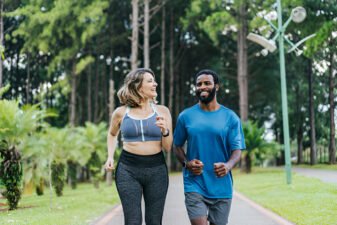Introduction
Regular physical activity provides enormous health benefits. It helps reduce heart disease, cancer, type 2 diabetes and many other diseases and metabolic conditions. Regular fitness exercise is also highly beneficial for weight reduction and weight maintenance, and may improve brain chemistry to reduce depression. By contrast, health studies that have monitored the wellbeing of large groups of people over many years clearly show that inactivity significantly increases the risk of overweight, obesity and chronic diseases.
The Health Benefits of Exercise
Studies show that regular physical activity:
– improves your chances of living longer
– improves quality of life
– reduces the risk of heart disease
– helps lower high blood pressure (hypertension) and high cholesterol
– helps protect you from developing certain cancers
– helps prevent or control type 2 diabetes (adult-onset diabetes)
– reduces the risk of arthritis and alleviates associated symptoms
– helps prevent osteoporosis (gradual loss of bone mass/strength)
– improves mobility and strength in later life
– alleviates symptoms of depression and anxiety
– benefits weight reduction and weight management
What is the Healthiest Type of Exercise?
Different types of exercise offer different benefits. Aerobic or cardio workouts primarily improve the cardiovascular system (heart, lungs), while weight-training or strength-training improves muscular strength and flexibility or stretching exercises improve overall mobility and coordination.
Cardiovascular Exercise
If you lead a fairly inactive or sedentary life, any increase in aerobic activity is good for you. Studies show that a brisk walk for even one to two hours a week (15 to 20 minutes a day) reduces your risk of having a heart attack or stroke, developing diabetes, or premature death. Weight-bearing aerobic exercise can also strengthen joints, and improve bone strength.
How Much Exercise is Needed?
The U.S. Surgeon General,(1) along with the Centers for Disease Control and Prevention and the American College of Sports Medicine, recommend getting a minimum of 30 minutes of moderate-intensity physical activity on most days of the week. You can do all 30 minutes at once or break it up into 10- or 15-minute periods.
Moderate intensity exercise or physical activity is activity that causes a slight but noticeable increase in breathing and heart rate. One way to gauge moderate activity is with the “talk test” – exercising hard enough to break a sweat but not so hard you can’t comfortably carry on a conversation.
Brisk walking is an ideal moderate-intensity activity. For the average person, a brisk walk means walking 3-4 miles an hour, or about as fast as you’d walk if you were late for a ball-game or PTA meeting!
Walking Improves Health
Research studies like the Nurses’ Health Study, Health Professionals Follow-up Study, Women’s Health Study, Harvard Health Study, National Health Interview Survey, Women’s Health Initiative, Honolulu Heart Program, and others show that this simple form of exercise substantially reduces the risk of developing heart disease, stroke, and diabetes in different populations.
30 Minutes Exercise is Not a Maximum Training Period
Although a mere 30 minutes of moderate-intensity activity a day is an excellent way to start, exercising longer, harder, or both can result in even greater health benefits.
Exercise For Weight Reduction
If you are walking or exercising mainly to reduce weight, 30 minutes or so a day will only be beneficial if you also monitor your calorie-intake. Even then, you may need to increase the duration or intensity of your workout. A report from the US Institute of Medicine reveals that it takes 60 minutes a day of moderate-intensity activity to maintain a healthy weight.
Among the 3,000 men and women who are part of the National Weight Control Registry, a select club that includes only people who lost more than 30 pounds and kept them off for at least a year, the average participant burns an average of 400 calories per day in physical activity. That’s the equivalent of about an hour of brisk walking.
Strength-Training
This type of exercise (also called weight-training or resistance training) includes any workout that uses resistance – like weights – to strengthen and condition the musculo-skeletal system. It includes, weight-lifting, resistance band workouts, cycling, climbing stairs, as well as exercises like pushups. Such exercises can improve metabolic rate, coordination, balance, muscle strength and overall physical condition.
Strength-Training Improves Metabolic Rate
The point is, muscle is metabolically active – it needs calories to work, repair and refuel itself. By contrast, body-fat needs very few calories to sustain itself. From our mid 20s onwards, we gradually lose muscle as part of the natural aging process. This means that the number of calories we need each day decreases. So if we continue to eat the same amount of calories, we gain weight. By taking regular strength training exercise, it is possible to reduce this loss of lean muscle tissue and even replace some that has been lost already. Health studies repeatedly show that strength training increases muscle mass, decreases fat tissue and raisesmetabolic rate.
Strength-Training Improves Bone Health
Another health benefit of resistance training is improved bone health. In addition to weight bearing cardiovascular exercise, strength training has been shown to reduce osteoporosis. For example, according to one study of postmenopausal women, 2 strength training sessions a week for one year increased bone mineral density by 1 percent. A sedentary control group lost 2 percent in the same time period.
Strength-Training Improves Physical Quality of Life
Among elderly people, resistance training can help improve/maintain the ability to carry out basic functional tasks such as walking, rising from a chair, climbing stairs and so on, thereby enhancing confidence, independence and quality of life.
Flexibility Training
Stretching exercises are also beneficial for health and physical fitness. Studies show that this type of flexibility training increases your range of motion, while reducing exercise-related muscle soreness and injury. In addition, by warming up and cooling down with 5 minutes of stretches before and after your workout, you will minimize the risk of looking bulkier, especially in your thigh and calf muscles.
Sources:
Harvard School of Public Health Nutrition
Physical Activity and Health: A report of the Surgeon General. U.S. Department of Health and Human Services, Centers for Disease Control and Prevention. (1996)
Pate RR, Pratt M, Blair SN, et al. Physical activity and public health. A recommendation from the Centers for Disease Control and Prevention and the American College of Sports Medicine. JAMA 1995; 273:402-7.
Manson JE, Hu FB, Rich-Edwards JW, et al. A prospective study of walking as compared with vigorous exercise in the prevention of coronary heart disease in women. N Engl J Med 1999; 341:650-8.
Hu FB, Sigal RJ, Rich-Edwards JW, et al. Walking compared with vigorous physical activity and risk of type 2 diabetes in women: a prospective study. JAMA 1999; 282:1433-9.
Tanasescu M, Leitzmann MF, Rimm EB, Willett WC, Stampfer MJ, Hu FB. Exercise type and intensity in relation to coronary heart disease in men. JAMA 2002; 288:1994-2000.
Lee IM, Rexrode KM, Cook NR, Manson JE, Buring JE. Physical activity and coronary heart disease in women: is “no pain, no gain” passe? JAMA 2001; 285:1447-54.
Sesso HD, Paffenbarger RS, Jr., Lee IM. Physical activity and coronary heart disease in men: The Harvard Alumni Health Study. Circulation 2000; 102:975-80.
Gregg EW, Gerzoff RB, Caspersen CJ, Williamson DF, Narayan KM. Relationship of walking to mortality among US adults with diabetes. Arch Intern Med 2003; 163:1440-7.
Manson JE, Greenland P, LaCroix AZ, et al. Walking compared with vigorous exercise for the prevention of cardiovascular events in women. N Engl J Med 2002; 347:716-25.
Hakim AA, Curb JD, Petrovitch H, et al. Effects of walking on coronary heart disease in elderly men: the Honolulu Heart Program. Circulation 1999; 100:9-13.
Jakicic JM, Marcus BH, Gallagher KI, Napolitano M, Lang W. Effect of exercise duration and intensity on weight loss in overweight, sedentary women: a randomized trial. JAMA 2003; 290:1323-30.
Institute of Medicine. Dietary reference intakes for energy, carbohydrate, fiber, fat, fatty acids, cholesterol, protein, and amino acids. Washington, DC: National Academies Press, 2002.
Wing RR, Hill JO. Successful weight loss maintenance. Annu Rev Nutr 2001; 21:323-41.
Ballor D, Poehlman E, Resting Metabolic Rate and coronary heart risk in aerobically and resistance trained women. Amercian Journal of Clinical Nutrition 1992; 56:968-74.
Broeder C, Burrhus K, et al. The effects of either high intensity resistance or endurance training on resting metabolic rate. American Journal of Clinical Nutrition 1992; 55:802-810.
Campbell W, Crim M, et al. Increased energy requirements and changes in body composition with resistance training in older adults. American Journal of Clinical Nutrition 1994; 60:167-75.
Nelson ME, Fiatarone CM, et al. Effects of high-intensity strength training on multiple risk factors for osteoporotic fractures. A randomized controlled trial. JAMA 1994; 272:1909-14
More Information About Weight Management










